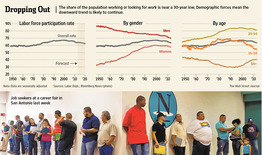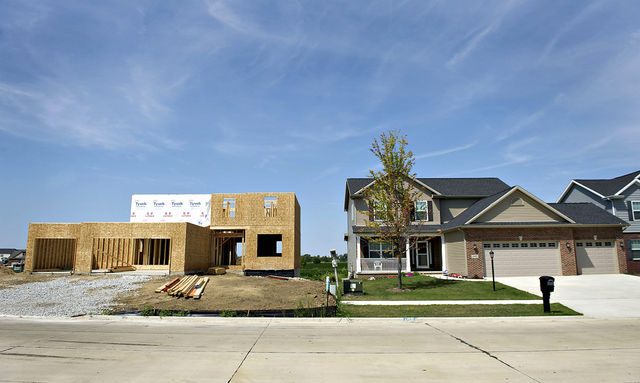Housing Still Precarious in Obama’s Second Term
by Dianna Olick CNBC Real Estate Reporter

The housing market is on the slow road to recovery. Home prices in the last three months rose in 120 out of 149 metropolitan markets surveyed by the National Association of Realtors.
Compare that to just 39 rising metros a year ago. The median home price is up 7.6 percent from a year ago, the strongest year-over-year increase since the first quarter of 2006.
Much of that is due to the shift in sales away from distressed properties, as lenders modify more loans and in some case write down mortgage principal.
The one thing standing in the way of a more robust housing recovery, is tight credit. Mortgage rates are at near-historic lows, but too many potential home buyers still cannot access these rates due to damaged credit.
“Mortgage-dependent buyers are still only bit-part players in the U.S. housing market recovery,” writes Ed Stansfield of Capital Economics.
So how does a second Obama term play into this still fragile housing market?
“The President’s victory is broadly positive for mortgage insurers and broadly negative for banks and homebuilders,” writes Jaret Seiberg, Senior Policy Analyst at Guggenhiem Partners.
Household formation is coming back, which is great news for the nation’s home builders, if they can obtain the financing they need to build and if their potential buyers can as well. That’s where the fiscal cliff comes in and the fear of another recession.
“The National Association of Home Builders urges President Obama and congressional leaders to work together to resolve issues related to the ‘fiscal cliff’ by extending all of the 2001 and 2003 tax cuts while being mindful of how broad-based tax reform will affect the fledgling housing recovery,” wrote NAHB chairman Barry Rutenberg in a release Wednesday.
Since housing finance barely came up during the campaign, and President Obama never gave voters any kind of vision about the future of mortgage lending, according to Seiberg, Fannie Mae and Freddie Mac will likely remain unchanged/unreformed through the mid-term elections in 2015.
The bigger issue is regulation in the mortgage market under Dodd-Frank legislation and the potential of the overall economy going over the fiscal cliff. Lenders face new rules on mortgage underwriting and how much mortgage risk they may be required to hold (QM/QRM). While a Romney administration could have stopped some of the rule-making (albeit not all of it), it will now go forward as planned. The mortgage industry is therefore reacting cautiously.
“We will ask for greater focus from this administration on ensuring that this regulation coming from so many different regulators is being considered more thoughtfully,” said David Stevens, president and CEO of the Mortgage Bankers Association. The MBA is renewing its call on the President to appoint a federal housing policy coordinator to act as something of a “traffic cop” to ensure “a coordinated housing policy where federal and regulatory agencies are effectively talking to each other” during the rulemaking process.
As for the millions of borrowers who still owe more on their mortgages than their homes are worth, the Obama administration has consistently said it wants to extend mortgage refinancing to take advantage of today’s record low rates. With Democrats still holding the Senate, it seems more likely they could get new legislation on mortgage refinancing, but analysts bet again the removal of Fannie Mae and Freddie Mac’s regulator, Edward DeMarco, who has stood staunchly in the way of lowering mortgage principal.
Fast-Growing Jobs That Don’t Require A 4-Year College Degree

The Huffington Post | By Harry Bradford
You might not need a bachelor’s degree to tap into some of the country’s fastest growing occupations, but some construction skills and health care know-how sure would help.
Why? Because it’s the medical and construction industries that appear likely to provide those without a college education the greatest job opportunities between 2010 and 2020, according to occupational expert Laurence Shatkin, Ph.D., author of 300 Best Jobs Without a Four-Year Degree.
Helper or apprenticeship jobs, such as carpenters and plumbers, may see particularly substantial job growth. Using Bureau of Labor Statistics data, The Huffington Post found in a separate study that temporary help services are one of the fastest growing job markets, increasing nearly 45 percent since 2009.
The health care industry is also expected to experience significant growth in the coming years, primarily due to an aging baby boomer population. Job listings for pharmacy technicians alone have grown 43 percent so far this year, according to a September study from CareerBuilder.com. Go get ’em, kids.
Older Americans’ Complicated Role in the Work Force

by Ben Casselman
The Outlook column in today’s Journal highlighted how an aging labor force is driving down the share of the population that’s working or looking for work, a measure known as the participation rate. But take a look at the charts accompanying the article, and another story jumps out: The participation rate among older Americans is actually rising.
At first glance, the two trends appear contradictory: If anything, older Americans seem to be driving the participation rate up, not down.
But while it’s true that Americans are working longer, it’s also true that they’re less likely to work than their younger counterparts — and less likely than they were when they were younger. 38% of those over age 55 were working in September, up from just under 34% a decade earlier. But nearly 76% of Americans between ages 45 and 54 are working — meaning they’re twice as likely to be employed.
Put another way: Today’s 55-year-olds are more likely to be working than 55-year-olds were 20 years ago. But an individual 55-year-old man is less likely to be working now than he was when he was 35. (The trend is even more pronounced for women, who flooded into the workforce in the second half of the 20th century.)
That means that the more people we have over age 55, the smaller the share of the population we can expect to be working. And with Baby Boomers now in their 50s and 60s, the over-55 population is growing rapidly.
These same demographic patterns explain what might otherwise be a perplexing trend in the labor market: the surge in employment among older workers. As of September, there were 3.5 million more Americans over age 55 working than when the recession ended in June, 2009. Among the rest of the adult population, employment has actually fallen by around half a million jobs. That might make it look like employers are engaging in reverse age-discrimination, hiring older workers instead of younger ones.
As any older job-seeker can tell you, that isn’t what’s going on. It isn’t that employers are hiring 55-year-olds — it’s that employed 54-year-olds are turning 55. Older Americans account for essentially the entire 8 million person increase in the adult population since the end of the recession. Based on the over-55 employment rate of 38%, we’d expect about 3 million of those 8 million to be working — more or less what we’ve actually seen. Employment trends, in other words, are following expected demographic patterns.
Why Housing Construction Is Rebounding
Housing construction was depressed to such a low level for so long that it wasn’t going to take much to boost the ailing sector.
What it needed was for demand to recover. Now, with consumer confidence rising and mortgage rates falling to their lowest levels on record, buyers are coming back.
It began earlier this year as investors scooped up properties at big discounts that they could rent at a profit—often buying homes out of foreclosure before they were taken back by banks.
Consider the case of Sacramento, Calif. The supply of previously owned homes listed for sale in September was down by 60% from one year ago, led largely by big declines in bank-owned listings.
Now, builders are benefiting from sharp declines in the share of foreclosed properties. Just 14% of local home sales in September were foreclosures, the lowest in more than five years and down from nearly 50% as recently as February 2011.
Many traditional sellers are underwater—they owe more than their homes are worth—or aren’t willing to list their homes at prices that are down sharply from five years ago.
That’s putting home buyers in a bind. “People are running out of options,” says Veronica Roberson, vice president of sales and marketing at home builder Taylor Morrison. “We’re down to less than a month of supply, so buyers are coming to new homes pretty urgently.”
At Taylor Morrison’s Sorrento East community in Dublin, Calif., where homes are priced from the mid-$600,000 range, sales have been running at a rate of five to six homes a month—more than double what was selling one year ago.
One growing concern in markets like Sacramento is that home sales volume is falling precisely because there aren’t enough homes for sale. Rising prices could lure more sellers. Phoenix, which has witnessed strong price growth, saw inventory pick up in September.
Even if sellers dither, builders won’t. Nationally, builders started construction on more units during September than any time in the past four years, after adjusting for seasonal factors, the Commerce Department said Wednesday. Single-family construction was up by 43% from last year’s anemic levels.
On a seasonally adjusted basis, the 141,000 newly built homes for sale at the end of August was the lowest since the government began its tally in 1963. Listings of previously owned homes are at a seven year low.
Meanwhile, applications for home-purchase mortgages last week hit their highest level since June and were 12% above their year-earlier reading, the Mortgage Bankers Association said on Wednesday.
Gains in construction should lift the economy. Glenn Kelman, chief executive of real-estate brokerage Redfin, writes in an op-ed at Quartz that builders have been completing “half-built projects” with “skeleton crews” for much of the past year. That hasn’t done too much for job growth. “It takes fewer cooks to prepare leftovers for dinner,” he writes.
But as more new projects get underway, that will change. Perhaps 2013 will be the year that housing really helps the economy accelerate.
iPad iNvasion, Part 3

by Teresa Burney
Fresh out of Penn State, the ink hardly dry on his civil engineering degree, Michael Burkentine started preaching the gospel of the Apple iPad to his home builder father.
The device could make the company’s operations more efficient and giving one to every home buyer would energize sales, Michael, 23, told his father, Paul Burkentine, who founded Burkentine & Sons in Hanover, Penn., the year Michael was born.
Paul, who had given his own iPad to Michael because he only used it for e-mail, was somewhat resistant, Michael says. So he used his own money to buy the first iPad for a customer after they signed a construction contract.
“He didn’t know that it would work,” Michael Burkentine said of his father’s reaction. “But it created quite a stir in the marketplace. We have a lot of customers coming into the store to see [the promotion.] It opened my dad’s eyes.”
“We were already giving a lot to our customers,” said Paul Burkentine, explaining his initial reluctance. “We do a lot of things above and beyond what other builders do. I felt like we already had an edge, then to add an iPad, geez that’s more money.”
Then he started noting buyers’ reactions and changed his mind. “It helps seal the deals,” he said, adding that it impresses all ages of buyers, from young customers to a recent buyer who is 80-something. He got further validation that the idea is a good one when a large national home builder, who was buying land from Burkentine came into the office and saw the small sign advertising the free iPad with a home purchase.
“These guys were national guys and they said, ‘Wow, that is a pretty good idea,’” Burkentine recalled.
Three Burkentine home buyers now have iPads that were given to them when they signed a contract for a new home.
“They are fully loaded with all kinds of stuff,” said Michael. “Customers are able to walk through the house [plan they chose] in a three-dimensional setting. Every piece of paper [in the buying process] goes on the iPad—the contracts, the documents, the addendums, and change orders.”
One of the first things home buyers do is use their iPad to select appliances, colors, and products, and design their kitchens at home before they go to the color selection meeting.
As the homes are built, buyers can see pictures of the progress on their house’s Facebook page, which they can share with family and friends. And, after they move in, the iPad reminds them to do maintenance, sending reminders for things such as air filter and smoke detector battery replacements automatically.
Michael is in the process of rolling out iPads to the company’s field employees now, something he says he did as a college intern for Whiting-Turner Contracting Company, a civil contractor. “I have that down to a science,” he said. “It’s just a matter of implementing it.”
Burkentine & Sons has been building between 20 and 30 homes for customers a year. To supplement business during the downturn, Paul said he has been building townhomes and renting them out. But now that more buyers are showing up, the built-to-sell portion of the business is growing again.
The successful iPad integration into Burkentine & Sons has shown Paul, 48, how quickly the right young employees can add value to an organization.
“You think you are hiring someone right out of college and you are going to have to wait for them to offer something to your business,” he said. “This shows how it does wonders to have young people in your business. It’s awesome; they bring a lot to the table.”
There are more young Burkentine’s destined for the family business. Paul has a set of twins who have just started at Penn State, also pursuing engineering degrees. One built a spec house last summer and the other will build one this coming summer.
So the business that he added “& Sons” to the name of after the birth of the twins 20 years ago this month is finally starting to live up to its name.
“Back then people assumed that I was the son,” laughed Burkentine. “The point it made was that we had a family business and people liked that.”
Teresa Burney is a senior editor for Builder.
Silence of the Camps: Obama and Romney are Hushed on Housing

By Clea Benson on September 19, 2012
Jerry Howard, chief executive officer of the National Association of Homebuilders, says he wants to know when President Barack Obama and Republican challenger Mitt Romney are going to outline plans for reviving the U.S. residential property market.
He’s not the only one. So far, discussions about housing by Obama and Romney on the campaign trail have been limited and vague, which makes the two politicians sound like they support most of the same ideas.
One reason for the relative silence: There are few solutions with wide appeal.
“The lack of talking about housing policy is not because it’s not important,” said Mark Calabria, director of financial regulation studies at the Cato Institute, which promotes free- market policies. “It’s because there’s not an easy answer.”
While the housing market is showing signs of recovery, the improvement is still meager compared to the damage. New home sales are still 50 percent below the average rate over the past 40 years. Almost 11 million families are “underwater” — saddled with more debt than their homes are worth after five years of declining home prices.
After nearly four years in the White House, Obama is facing criticism that his relief programs for borrowers have lacked broad and aggressive measures and have reached fewer families than intended.
Blueprint Delayed
Moreover, some promised initiatives remain undone. The president has yet to unveil a blueprint for overhauling the nation’s housing finance system and winding down Fannie Mae (FNMA) and Freddie Mac (FMCC), the taxpayer-owned companies that back about 60 percent of the U.S. home loan market and have been supported with $190 billion of capital injections. New regulations governing mortgage securitization that were mandated by the Dodd-Frank Act in 2010 have yet to be written.
On the campaign trail, Obama’s discussion of housing focuses primarily on helping distressed homeowners refinance into historically low interest rates. That’s a position that doesn’t alienate voters who resent government aid going to delinquent borrowers, since most people who qualify for refinancing programs must be current on their mortgages.
“The issue is so divisive, because everybody feels you need to do something about the housing market,” Calabria said. “But there’s still a lot of the feeling of, ‘I don’t want to bail out my neighbor who isn’t paying his mortgage’.”
Refi Expansion
On a visit to Nevada last week, where 60 percent of homeowners are underwater, Obama urged Congress to vote on a Senate bill that would expand a government program that helps such borrowers cut their interest payments.
Activist groups typically aligned with Democrats say that’s not enough. They want more details on the president’s future plans for foreclosure prevention, neighborhood aid, and overhauling the housing-finance system.
“Assuming there’s not a radical shift in the alignment of Congress, what’s President Obama going to do differently in his second term to achieve his goals?” said Alan Jenkins, executive director of the Opportunity Agenda, an organization that promotes economic opportunity.
Brian Deese, deputy director of the National Economic Council at the White House, said Obama has been talking about a broad set of housing initiatives in recent public appearances, including a proposal to spend $15 billion on redevelopment of neighborhoods devastated by the housing crisis.
“He has a proposal on the table, and if Congress will work with us to make some progress on it, it would make a material difference for those communities,” Deese said.
Few Details
For his part, Romney has provided few details on how he would approach the housing market and foreclosures differently than Obama.
He has shifted his position on whether the government should intervene to stop foreclosures. He told a Las Vegas newspaper last year that the housing market should be left to hit bottom on its own. Then, in January, Romney told Florida voters that a “more concerted effort” was needed, saying “the idea that somehow this is going to cure itself by itself is probably not real.”
Romney was overheard at a fundraiser in April saying he might abolish the Department of Housing and Urban Development, the department that his father, George Romney, headed during the administration of President Richard Nixon.
It wasn’t until earlier this month that the Republican nominee posted a four-point plan on housing on his campaign website.

